I was the first foreign pilot to fly the Mach 2.8 MiG-31 interceptor, here’s my story: By Air Marshal Anil Chopra (Retd)

Weighing the same as a M60 main battle tank and capable of flying 600mph faster than an F-16, the Russian MiG-31 is an absolute beast of an interceptor. Cloaked in secrecy, few outsiders have flown in the cockpit of this monstrous defender. Air Marshal Anil Chopra PVSM AVSM VM VSM (Retd) was given privileged access to the world’s fastest armed aircraft, here he describes this incredible experience to Hush-Kit.
“I felt I was sitting atop a missile-head in a high-speed interception.”
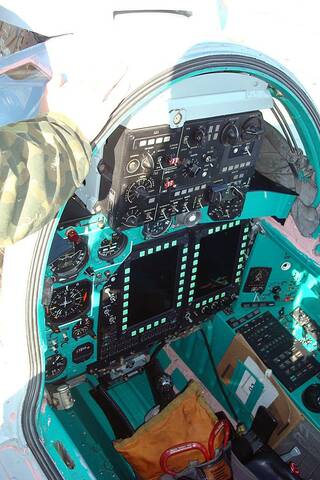
“The date was 28 May. Average daytime temperatures in May in Nizhnie Novgorad are around 22℃. Airfield elevation was 256 ft. The take-off and landing were done by the front pilot. The rear cockpit is used mostly as Weapon System Officer (WSO) station, though it has a control column to fly in case of an emergency requirement. There was nothing peculiar about the take-off. The frontal view through the periscope was good. I had used the periscope earlier on MiG-21UB (trainer) and on the MiG-23UB. So, I was quite comfortable. However the side view was minimal as the large front canopy left little place for Perspex for the second cockpit. I tried to visualise if the second pilot could easily land from the rear seat. Compared to a Su-30MKI it is surely more uncomfortable.”
Why did you try the MiG-31?
“I was the team leader of the Indian Air Force (IAF) MiG-21 Upgrade ‘Bison’ project in Russia from mid-1996 to the end of 2000. The design and development work was carried out at the Mikoyan Design Bureau in Moscow’s (OKB-155, Experimental Design Bureau 155). Our location was at RAC ‘MiG’, 6, Leningradskoye Shosse, Moscow. In 1995, Mikoyan OKB had merged with two production facilities to form the Moscow Aviation Production Association MiG (MAPO-MiG). Rostislav A. Belyakov, was still the father figure. I had an opportunity to meet him.”
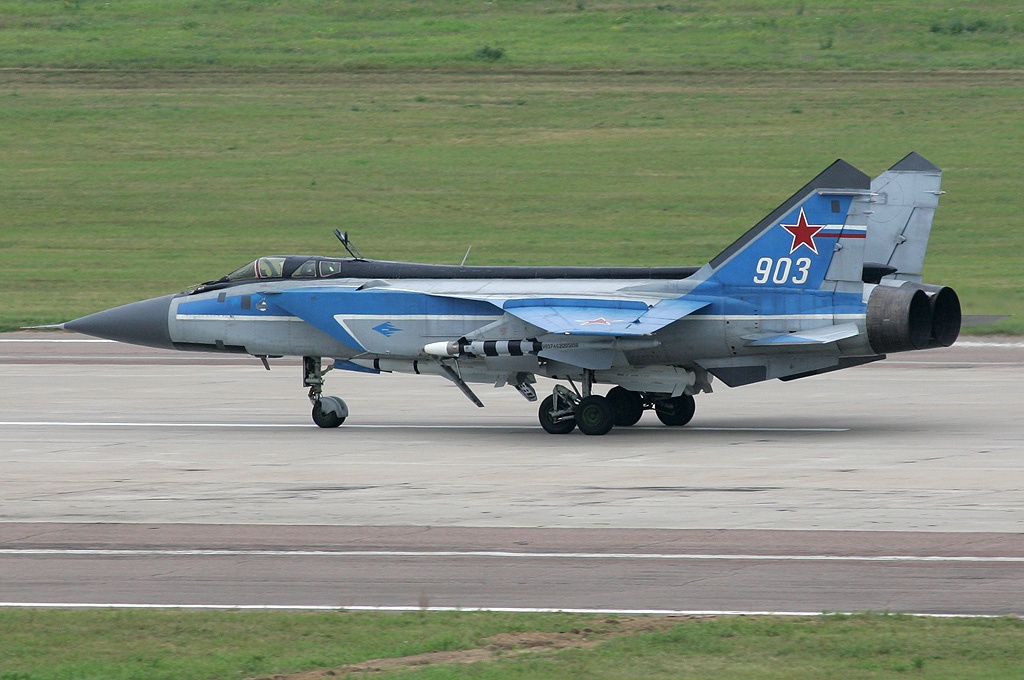
“Two MiG-21Bis Aircraft had been sent from India for the design and development project. These aircraft were in positioned at the Sokol plant in Nizhnie Novgorod, where they were to be stripped and rebuilt after receiving the final design drawings from the Moscow Design Bureau. Sokol was also where the MiG-31 was being built. Our team used to visit the Sokol plant regularly from 1997, nearly once a month, for progressing the work on our two aircraft. Two of our officers were later permanently at Sokol for the flight testing of the Bison. The Director General of the plant, V Pankov mentioned to me about the MiG-31 and said that the Russians had been proposing the MiG 31 for sale to India. He said that they had given details to both the Government of India and to the Indian Air Force, but had not received any response or interest. I asked them to show us the aircraft, and if they had no problem, then I could get a chance to fly it. In Russian armament industry the general dynamics were still of the Soviet era. It took him some time to get approvals for me to fly in the rear seat of the MiG-31. They also told me that I was to be the first pilot from a foreign country to fly a MiG-31. They gave me a certificate to that effect, which is currently lying misplaced somewhere in my boxes. It was a demonstration flight and not a test flight. The basic aim was to show case the long range radar and to demonstrate high speed and acceleration. The date fixed was 28th May 1999. That was also the day the deputy head of India’s Mission in Moscow was on her first official visit to the Sokol plant. Ms Nirupama Rao was later India’s foreign secretary and India’s Ambassador to USA.”
Where did you fly it?
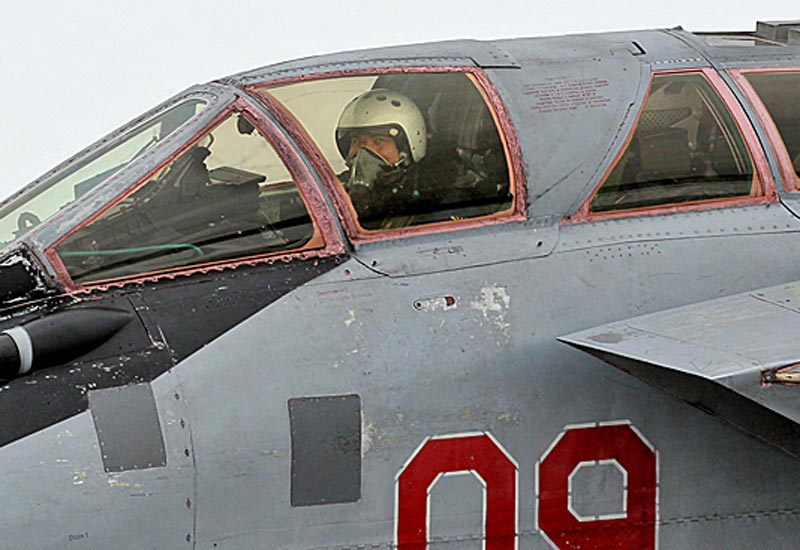
“The flight was made in the Sokol Aircraft Plant in Nizhniy Novgorod, which was formerly called Gorky. The plant was a manufacturer of MiG fighters. It was reportedly founded in 1932 and was once known as ‘Aviation Plant 21’, named after Sergo Ordzhonikidze. During 45 years of serial production the plant had manufactured about 13,500 combat aircraft. We were told that at its peak, they use to make close to 200 MiG-21s a year. But after the collapse of Soviet Union, and in the absence of significant orders from the Russian Air Force Voyenno-Vozdushnye Sily (VVS), the production had gone down. The Indian MiG-21 upgrade was a significant order. Also, the plant used to make around 10-12 MiG 29 two-seaters in a year. There were nearly 15,000 employees. Their salaries were very low in the mid 1990s. Most of the sales and money earned from armaments was controlled directly from Moscow. All foreign contracts were through Rosvooruzhenie (later Rosoboronexport), the sole state intermediary agency for Russia’s exports/imports of defence-related and dual use products, technologies and services. We were told that the entire plant, including salaries could be run through the sale of just two MiG-29s. It was clear that the aircraft sale price was very high and basic production costs and salaries were very low. The high mark-ups of defence equipment prices are true in all countries. For some exported components, the price mark-up could be a 100 times. Many smaller plants that were the real original equipment manufacturers (OEM) of the components or sub-systems, wanted to sell spares directly to India, but the Russian government control was never released and with the result that the bulk of the profits went to Moscow.”
Interview with Indian Air Force MiG-29 pilot here
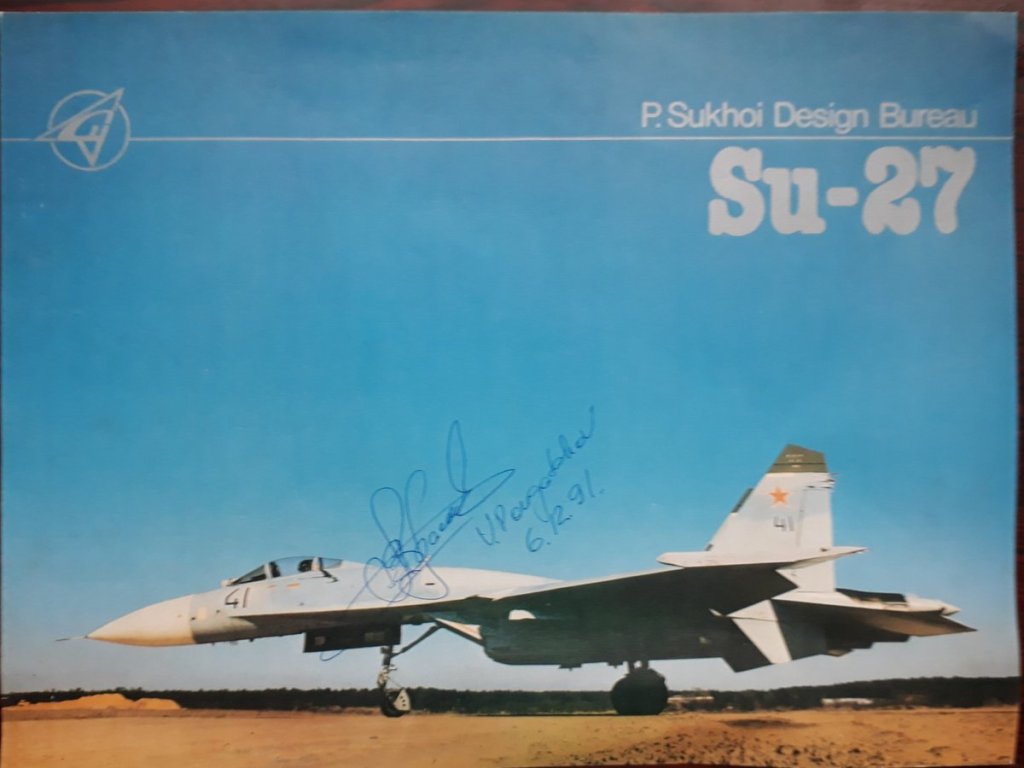
Russian people take a little time to make friends, but once they become one, they are great friends. There were many very senior technicians in the plant who had been to India in 1960s to help set up the MiG plant at Nasik. They had fond memories and spoke about the great time they had in India, and how they loved Indians. They also remembered the great Indian Old Monk Rum. We arranged to get some from India for them.
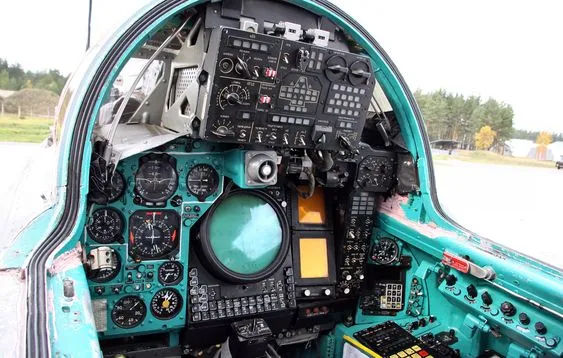
The production facility was next to the airfield (also known as Sormovo airfield), which was also the civil airport. For a long time, the plant was considered the most important industrial enterprise and main employer of the region. In those hard days, the plant was making many aluminium and other alloy based products, like river boats, frames for doors and windows, and even metro coach shells. We have heard that in later years they even encouraged flight tourism for MiG-29 to generate additional income.”
General Capability Briefing by the Russian Designers

“The MiG-31BM that I was to fly was reportedly a multirole version with partially upgraded avionics, new multimode radar, HOTAS controls, LCD colour multi-function displays (MFDs) in front cockpit, and ability to carry the R-77 missile and other Russian air-to-ground missiles (AGMs) such as the Kh-31 anti-radiation missile (ARM). It also reportedly had a new and more powerful computer, and digital data links. The aircraft was called Prospective Air Complex for Long-Range Interception. The Zaslon phased-array PESA radar would allow firing long-range air-to-air missiles. Its maximum range against fighter-sized targets was claimed as 200 km. The radar could track up to 10 targets and simultaneously attack four of them with its Vympel R-33 missiles, they said. But eventually the radar would track 24 airborne targets at one time, and attack six simultaneously, they said. Actual development status of radar at that time was not known to us. An upgraded, larger Zaslon-M radar, would later have detection range of around 400 kilometres for AWACS class targets.
There was an infrared search and track (IRST) system in a retractable under nose fairing. Its tracking range was 56 kilometres. The eventual variants were to have various air-to-ground missiles integrated, that included six anti-radiation missiles, or anti-shipping missiles or six precision TV/Laser bombs like KAB-1500. Maximum external load mass was 9,000 kilograms. The MiG-31’s main armament was four R-33 air-to-air missiles. Fuselage could reportedly carry four R-33 or six R-37 missiles. Four underwing pylons could carry combinations of drop tanks and weapons. MiG-31BM could also carry the Kh-47M2 nuclear-capable air-launched ballistic missile with a claimed range of more than 2,000 km, and a Mach 10 speed.
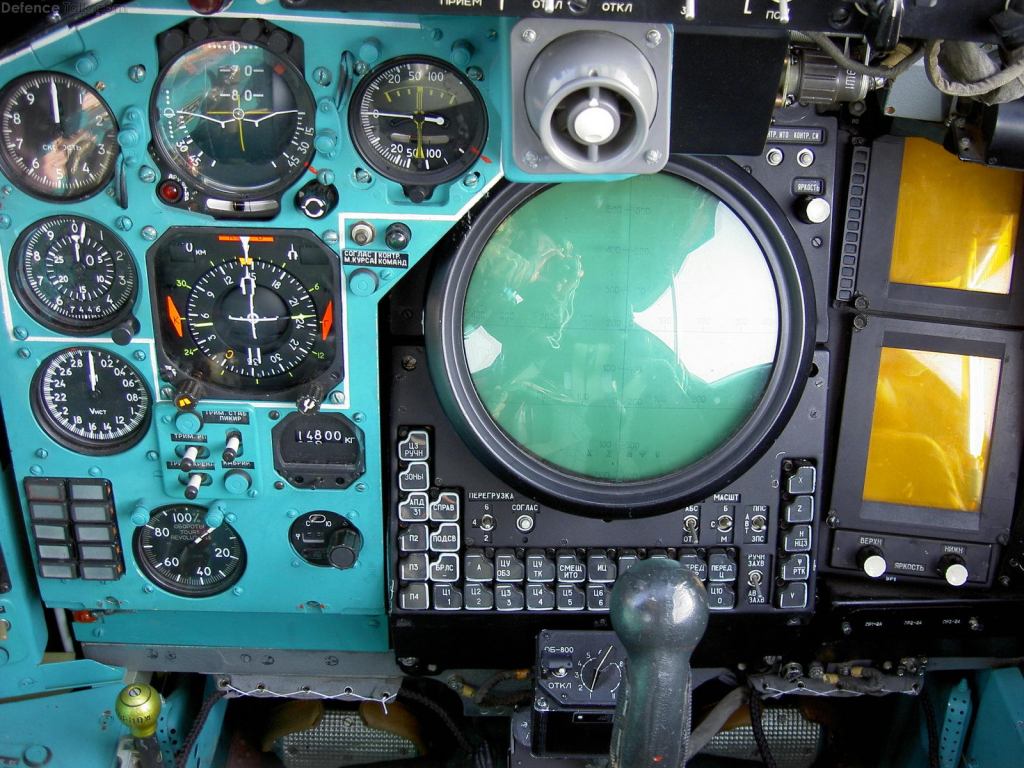
The MiG-31 was equipped with digital secure data-links. Details were not told, but they mentioned that the aircraft radar picture could be transferred to Indian Su-30s and MiG-29s. Also the ground radar picture could be received by the MiG-31 and transferred electronically to other aircraft. Thus allowing radar-silent attacks. There was a choice to slew missiles and fire based on inputs from other aircraft through the data-link. The MiG-31 had radar ECMs. Details were not discussed. The onboard navigation and attack system had two inertial systems supported by digital computer.
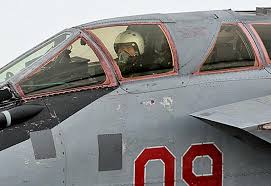
A detailed briefing on the aircraft was carried out first by Russian designers, and then was the pre-flight briefing by the pilot. Designers told us that though evolved from the MiG-25, there were significant changes. The aircraft fuselage was longer to accommodate the radar operator’s cockpit and there were some other new design features. The wings and airframe of the MiG-31 were stronger than those of the MiG-25. The advanced radar, with look-up and look-down/shoot-down capability and multi target tracking and engagement was a significant improvement. The aircraft had advanced sensors and weapons. Radar they said was much better and worked well even during active radar jamming. They highlighted cooperative work, between a formation of four MiG-31 interceptors, using data-links, which could dominate a large front and airspace across a total length of up to 900 kilometres. The radar had maximum detection range of 200 kilometres. They claimed that the aircraft radar and weapons combination could intercept cruise missiles flying at low altitude, and also the launch aircraft. Similarly it could take on UAVs and helicopters. The automatic tracking range of the radar was 120 kilometres. The aircraft could act as air defence escorts to a long range strategic bombers. The MiG-31 was not designed for close combat or high-g turning.
They also mentioned that the Russian Air Force was already flying the MiG-31, and a few hundreds had been produced by the Sokol plant. The Kazakhstan Air Force had also retained some numbers after Soviet dissolution. They took pride in mentioning that the MiG-31 was among the fastest combat jets in the world. The aircraft had years of service ahead. Cash-strapped Russia was very keen for the IAF to buy the MiG 31.
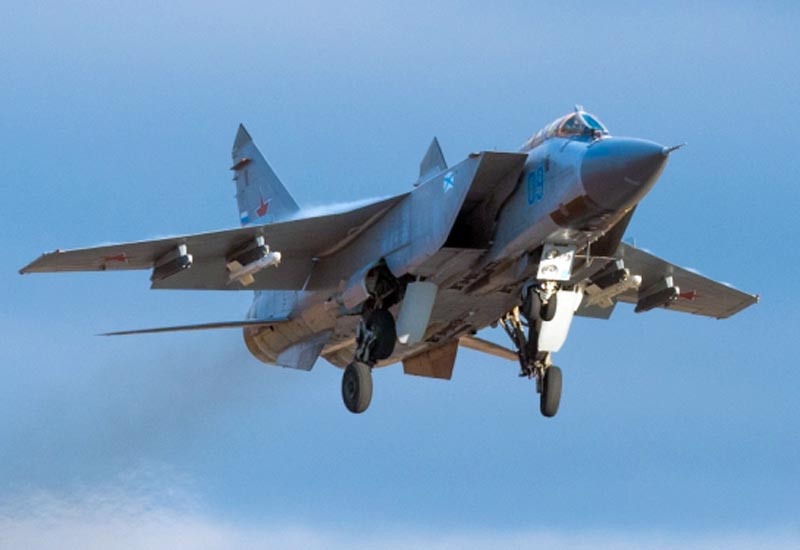
What were your first impressions?

The blue and white painted huge aircraft with tail number 903 looked most impressive and overbearing as one walked towards it. To start with, the MiG-31 is big. You might say huge. This was the then under development MiG-31BM (air defence) variant. I had read up about the MiG-31. I had earlier seen the MiG-25 in India, though I had not flown it. This one was freshly painted aircraft and much better looking. This was the aircraft which was to be used for display during air shows. As one walks around the aircraft for external checks, one gets to see the huge nose cone that housed the RP-31 N007 ‘backstop’ (Russian: Zaslon) radar. Air intakes were side-mounted ramps. Looking into the huge intake was like looking into a tunnel, and one could see the first stage of the huge engine. With a high shoulder-mounted wing, one could comfortably walk under the aircraft. The undercarriage was peculiar. There were two main wheels in each side and these were in Tandem but not aligned with each other. We were told that the undercarriage had been strengthened to take greater weight, also the fuselage was clearly longer. One recalled that the MiG-25 had only one main wheel each side. Russians also demonstrated the peculiar way the wheels retracted into the fuselage. The wheel trolley did a full forward rotation before entering the wheel bay. The tail side was somewhat similar to MiG-25, though longer a little but difficult to make out.
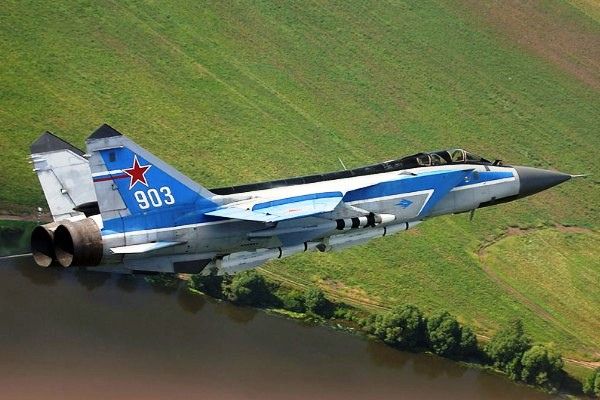
On entering the cockpit, I was briefed by the pilot, Alexander Georgiyevich Konovalov. We were not allowed photography in the cockpit. The front cockpit was still like the other Russian cockpits with green colour and standard old instrumentation. There were two MFDs which had been introduced in the front cockpit. It looked like a cut and fit task as is the case in developmental aircraft cockpits. The rear cockpit had the old round CRT radar scope. The front cockpit had a standard Russian control column with autopilot and weapon controls. The rear seat had a control stick with no control buttons on the stick-head. This rear-stick could also be removed and stowed away for better radar work. Once the canopy was closed the outside view reduced considerable in the rear cockpit. One got a feeling as if one was seated in a submarine. There was a big periscope to see outside. The cockpit seemed more optimised for WSO role and less for flying.”
How does it compare with the MiG-25?
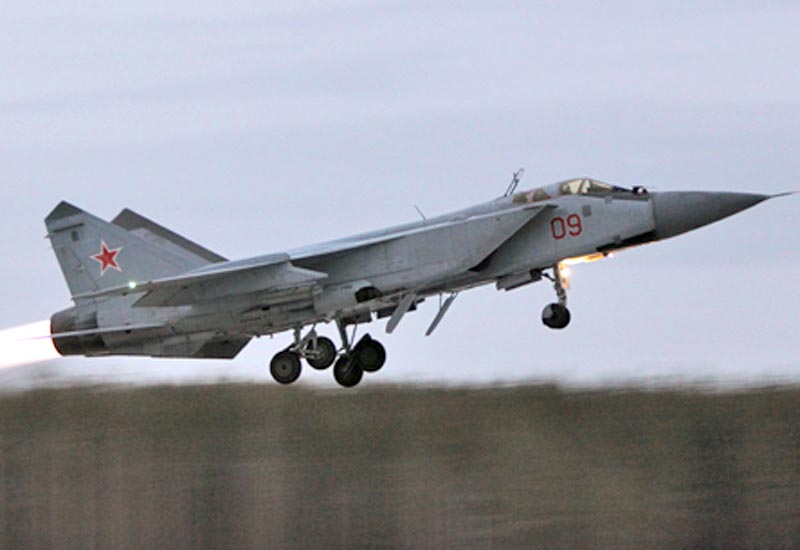
Both the MiG-25 and MiG-31 were designed as interceptors. The MiG-31 was greatly upgraded to house an advanced radar, digital data links and the more powerful engines. The aircraft had to be made longer. The gross weight of MiG-31 had gone up to 41,000 kg (90,390 lb) vis-à-vis the 36,720 kg (80,954 lb) of the MiG-25. The MiG-31 had two Soloviev D-30F6 engines with 93 kN (21,000 lbf) dry thrust each dry, and 152 kN (34,000 lbf) with afterburner, compared to two Tumansky R-15B-300 engines, with 73.5 kN (16,500 lbf) dry thrust, and 100.1 kN (22,500 lbf) with afterburner for MiG-25.
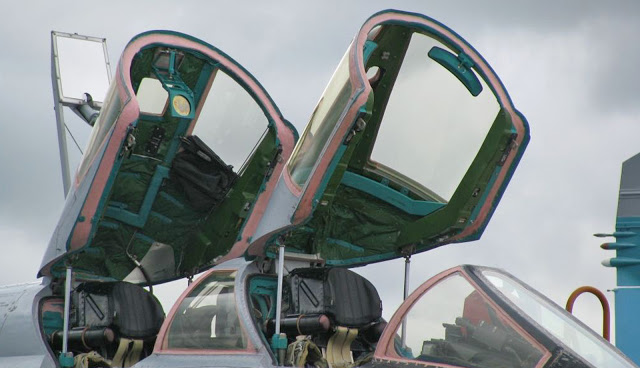
The MiG-31 was clearly an upgraded design, though it would be wrong to call it a totally new design. Strengthened wings allowed a small increase in max G from 4.5 to 5G, and better acceleration and low-level flight. The MiG-25 radar, was primarily optimised for high-flying targets, but the Zaslon radar of the MiG-31 could detect and track low flying aircraft (look-down/shoot-down capability). The same was demonstrated in flight by locking on to a low-flying MiG-21 that had taken off from same airbase. The rear cockpit in the MiG 31 has been optimised for the Weapon System Operator. The WSO was entirely dedicated to radar operations and weapons deployment. The MiG-31 radar was passive electronic scanned array (PESA) whereas the MiG-25 had older variants of vacuum tube or semiconductor radars. While the MiG-25 (generally) carried only air-to-air missiles, the MiG-31 also carried air-to-surface missiles that included up to four Kh-58UShKE anti-radiation missiles or one Kh-47M2 Kinzhal hypersonic air-launched ballistic missile.
Interview with Indian Air Force Su-30 pilot here
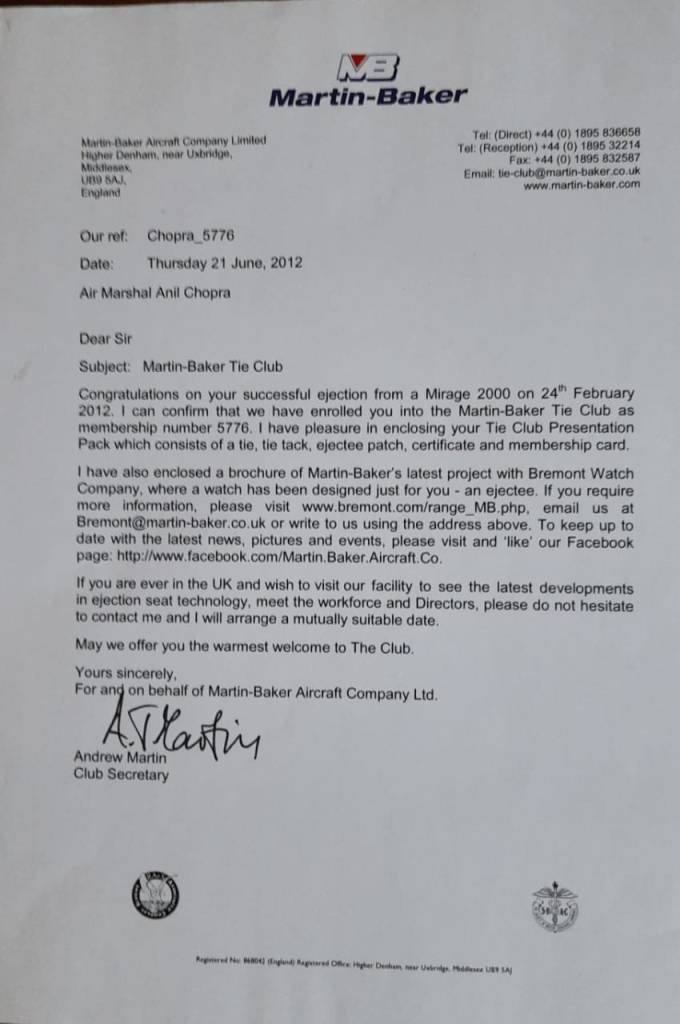
How well did it accelerate?
“The aircraft accelerated quickly, as if someone was pushing from behind with enormous brute force. Having flown the MiG-23MF whose Tumansky R-29 (R-29A) engine (123 kN (27,600 lbf) thrust) give it excellent acceleration, the MiG-31 was similar. During our sortie we climbed up to 15 kilometres, and accelerated to max M 2.7. The transition to supersonic and subsequent cruise was very smooth. We also flew at low-level to see the acceleration, but did not hit max speed or go supersonic, though the aircraft had the ability. The aircraft pushes ahead like a rocket.”
What was take-off and landing like?
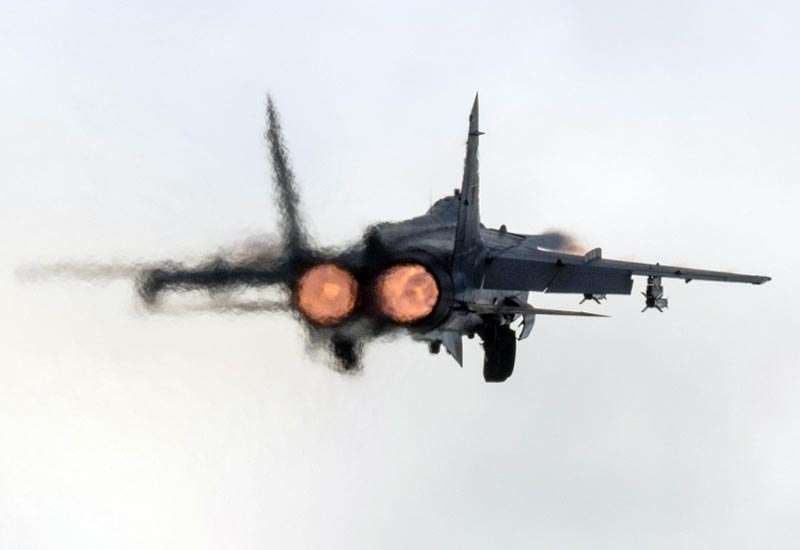
Describe your flight
“The sortie was designed to demonstrate the radar interception performance, aircraft acceleration and general handling. The rear cockpit has only two small vision ports on the sides of the canopy. Fighter pilots are more used to having a great external view. I felt a little claustrophobic. But reconciled to it. There were side screens to make the cockpit darker for better viewing of the radar scope. After take-off the pilot kept the afterburner on for a little while to demonstrate a high rate of climb. We climbed initially to 6 km. Konovalov spoke decent English. He allowed me to handle the controls. The aircraft handling was somewhat sluggish, more like a bomber than a fighter. The rear control stick felt more like holding a rod rather than a control column.
Here we did some radar work. He kept instructing me on how to put on the radar and allow it to warm up and settle down. He also told me how to change range scale. The picture was more like the old time CRT displays of the raw blip type. He showed me an airliner at around 185 km. Since the airliner was not under our ATC control, we did further radar work with a MiG-21 that had taken off from the home base. We locked on to the MiG-21 around 85 km. Later the MiG-21 was asked to descend to a lower height of about 1 km. Then we saw the look-down mode. I do not recall at what range we locked on. I think it was certainly around 40 km. We then climbed to 15 km, where he accelerated the aircraft to M2.7. Acceleration was smooth and fairly quick. He allowed me to be on the controls during acceleration. There was no buffet on the aircraft or on control column. Subsequent deceleration was also fast. For quicker deceleration we initiated a turn (3G).
Once subsonic, I carried out a few turns pulling around 4G. Turns appeared sluggish. In any case the aircraft was cleared only for max 5G. Yes the aircraft was easy to handle, but appeared more like a weapon launch platform up in the sky than a fighter. We then descended to low-level. The MiG-25 was known to be difficult to fly at low-levels. The Russians had made some aerodynamic airframe modifications on the MiG-31 for better low altitude handling. We did an acceleration to around 1100 km/h. The acceleration was smooth. I did not notice any buffet or other aerodynamic effects.”
What was best about it?
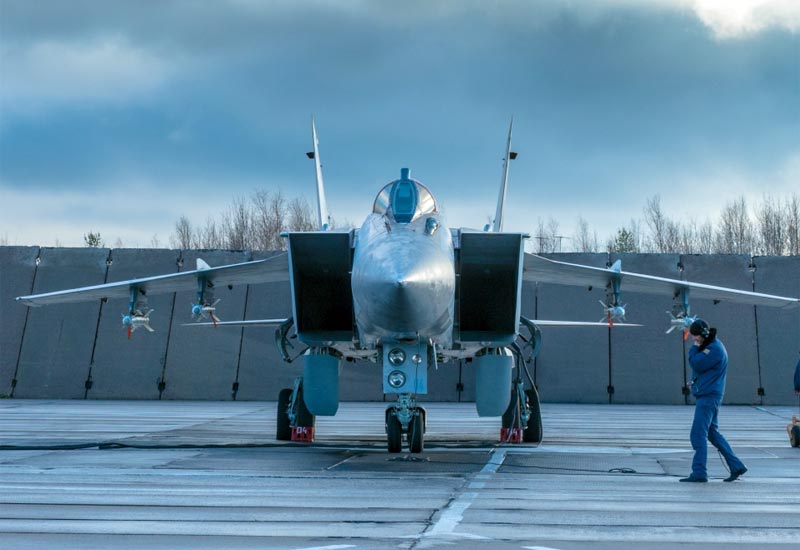
“The best part of the aircraft were the acceleration and the long-range radar. I had been told that aircraft has some very long-range missiles. Also the aircraft had been used to launch satellites. The aircraft had significant weapon carrying capability. However, many modern smaller fighters can carry similar tonnage.”
What was worst about it?
“I think it is not appropriate to call anything ‘worst’. I would hardly call it a fighter aircraft. It was basically a weapons platform in the air. More like an atmospheric satellite, or an airborne cruise ship. I also thought that the aircraft still required more refinements in its avionics, displays and cockpit instrumentation. The WSO station in an Su-30 MKI or Phantom F-4 had an excellent external view, this did not. Essentially designed as an interceptor, one could not call it a fighter in conventional sense. I understand that subsequently, the rear cockpit also got an MFD, otherwise working on the old CRT type round scope was not good for situational awareness and information display. For a Mirage 2000 pilot like me, it was a little confusing initially.”
“Comparing the MiG-31 with Rafale is like comparing Bruce Lee with a Para Special Forces Commando.”
How comfortable is the cockpit?
“I sat in the front cockpit for a few minutes. It was like any Russian cockpit with its green panels and black instrument dials. Having flown the MiG-21, MiG-23BN and MF, and few sorties on the MiG-29 earlier, the cockpit looked very familiar. Some of the instruments were same, others had to change to cover a different range of flight parameters. Two MFDs had been brought in. One could see the cut and paste done to the old cockpit to introduce them. One could make out that more changes were still in the offing. The cockpit was spacious like all Russian aircraft, catering for the well-built and well-clad Ruskies. The ejection seat and strapping was also familiar. One thing I always liked about the Russian cockpits was that there was no need for pilot to wear leg restraining straps, as they were part of the cockpit and seat arrangement. The layout of the throttle, stick and positioning of switches appeared good as per flight usage requirements. This had obviously evolved over the years in all counties. Having interacted very closely with Russian designers, especially the cockpit specialists, in our upgrade project, one knew that they were very knowledgeable and real masters at their job. The rear cockpit was somewhat suffocating and tight. Holding the control column was like holding a round-headed walking stick. The stick could be removed from the base and stowed away. Instrumentation in the rear was awaiting an upgrade. Later pictures of the rear cockpit (on the internet) indicate that the MFDs had been introduced.”
How loud is it for the crew?
“The cockpit was well sealed. After all, the aircraft was meant to fly at very high altitude and at very high speeds. I flew with the normal Russian inner and outer helmet. Same as used on MiG-21. The noise level was reasonably low. Even at high supersonic speed it was quite comfortable and one could converse with other pilot comfortably.”
Why the IAF did not buy the MiG 31?

“Russians had made many attempts to try convince the Indian Government and IAF to go for this “multirole aircraft”. Their main USP was long-range missiles (carrier killer and anti-satellite) and a multi-role platform. India had good experience of the MiG-25, albeit mostly in the reconnaissance role. The IAF well understood the complexities of maintaining an aircraft of this type. The MiG-25 had been bought for high altitude reconnaissance. By now, India had its own satellite based reconnaissance capability. Also more and more UAVs were being used for ISR work. Notwithstanding the upgrade, the MiG-31 remained an old platform inherently designed for high-altitude, high-speed interception. It could not be compared to a modern multi-role aircraft. The IAF had already made up its mind with the Su-30MKI for which the contract was actually signed while we were in Russia. We were also interacting closely with the Indian Su-30MKI upgrade team in Moscow. India was also not keen to put the IAF more into the Russian basket. India had had a great experience with Mirage 2000, and was also looking at adding more upgraded variants of the Mirage 2000. Also India had done its threat perception study. It had seen how its own neighbourhood was evolving. India had no such threat from Pakistan. Yes, India needed long-range missile and interceptors for China. But the same could be achieved by putting a long-range missile on any other aircraft. Having a large radar with long-range was the main advantage with MiG-31 which was not possible on smaller aircraft. But technologies were evolving and later better radar performance was possible from smaller radars. In any case the Su-30MKI had a large area of real-estate in its nose. Interestingly the MiG-31A has been used to launch commercial satellites and MiG-31S have been used to train astronauts, to conduct research in the upper atmosphere and for space tourism by launching the aerospace rally system rocket-powered suborbital glider.
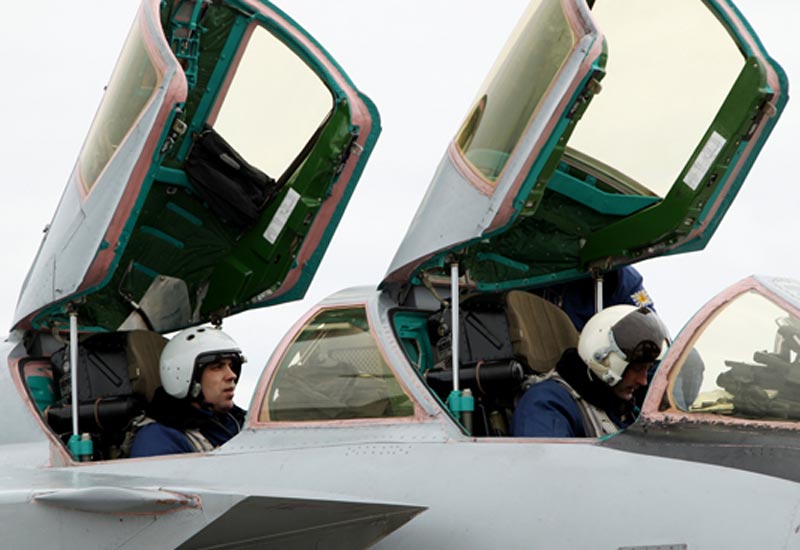
Dear reader,
This site is in danger due to a lack of funding, if you enjoyed this article and wish to donate you may do it here. Your donations keep this going. Thank you.
Follow my vapour trail on Twitter: @Hush_kit
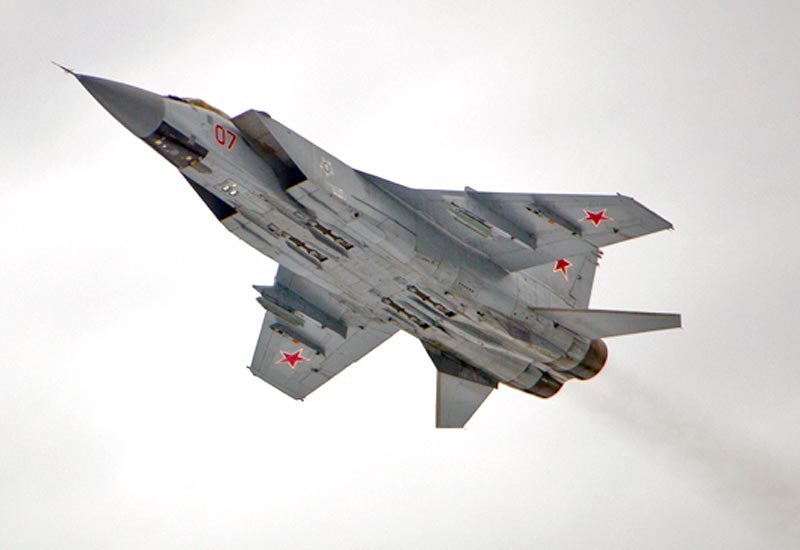
“Not many countries had shown interest in the MiG-31. India also not very sure about the MiG-31’s projected radar capability. Even the Chinese had chosen many Su-30 variants instead of the MiG-31 despite greater potential potency. Unlike the MiG-31, the Su-30 variants manoeuvre very well. The Sukhoi design bureau was also much more aggressive in its marketing. Even a MiG-35 from the Mikoyan stable was considered a better bet, but then India already had plans to upgrade the MiG-29. There was no need immediately for IAF at that time to have an AWACS killer missile. The MiG-31’s capability to launch anti-satellite (ASAT) was not of immediate interest to India. India was already building its own surface based ASAT capability. The IAF’s finite budget allocations could not afford too many platforms. Also buying just 10-12 MiG-31s would have added more logistics complexities to the IAF which already had a plethora of types. As per my knowledge, IAF never did a formal evaluation of the aircraft. The MiG-35 which Russians claim can shoot down almost all kind of reconnaissance drones and other platforms like AEW&Cs and the U-2 spyplane, is one of the contenders of the 114 new fighters India is going to evaluate in the near future.”
What are your feelings on Western versus Russian aircraft – do you have a personal preference and if so, why?
“I have flown a fair number of both Western and Russian aircraft. I have nearly 1,000 hours on MiG-21 variants (MiG-21FL, MiG-21M and MF and MiG-2Bis). I was an instructor on the MiG-21. The MiG was my initial year’s aircraft. I was a pioneer of the Mirage 2000 fleet and commanded a Mirage 2000 squadron, and have around 1200 hours on type. I also happened to have ejected from a Mirage 2000 at the ripe age of 59 years – and two months into the rank of Air Marshal, a sort of record of its own kind. I have also flown the MiG-29, Su-30 MKI, Jaguar and the Hunter, among others.”
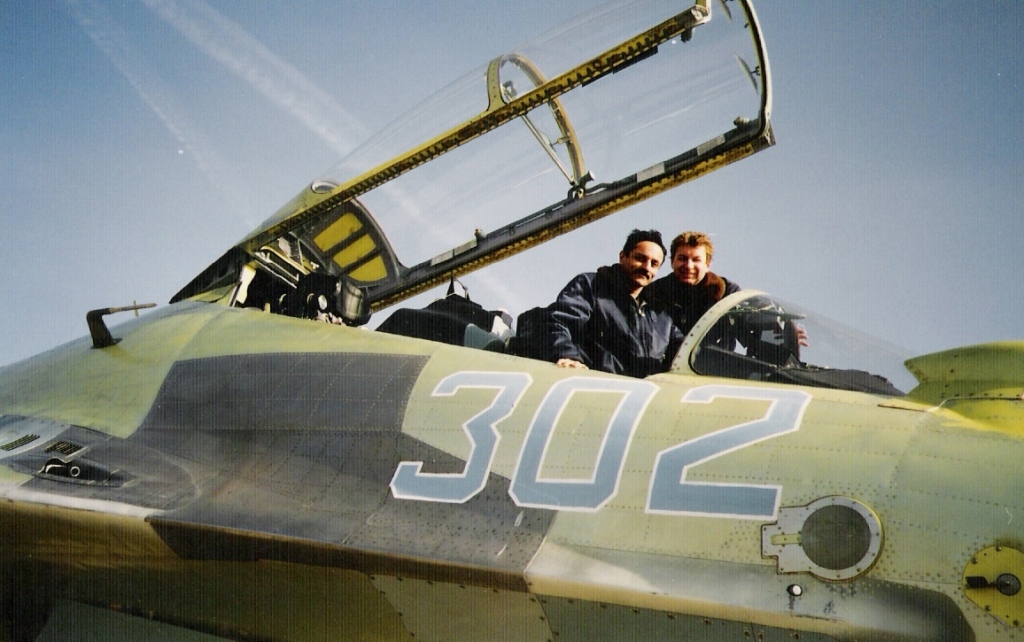
I had earlier done a flight on the Su-27 on 6 December 1991 (my birthday) in Delhi with the famous Russian pilot Viktor Pugachev (of the Cobra manoeuvre fame). I had also flown the Su-30K at Zhukovsky flight test airfield in Moscow with Test Pilot Slava on 13 May 1997. Also flown the under development MiG AT at the same airbase, and the Yak-131D at Sokol. So I have no specific loyalties and can make an independent comment. I had had an occasion to be present at Zhukovsky airfield when the Mikoyan Project 1.44/1.42 aircraft (NATO name: Flatpack) technology demonstrator developed by the Mikoyan design bureau was revealed to the world. Later it had done its maiden flight in February 2000.
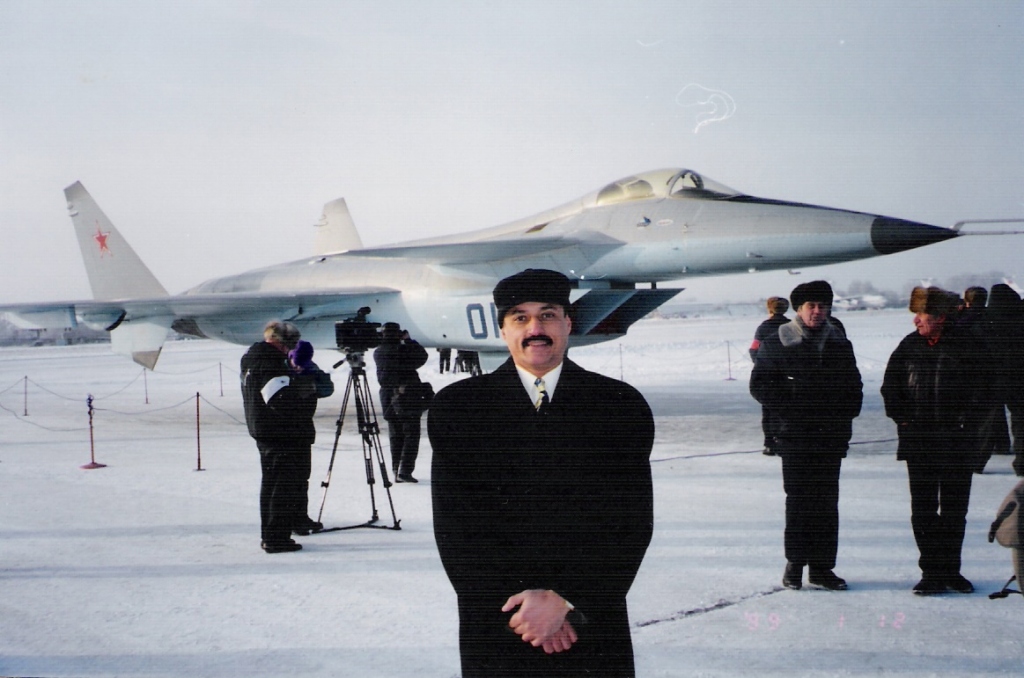
Both, the Russian and Western aircraft had their own strengths, weaknesses and idiosyncrasies. Russian aircraft were simpler in design, the cockpits were big, more mechanical than complex electronics, and had high standardisation and commonalty. Switching from one Russian aircraft to other was so much easier. I like the levelling mode of Russian autopilot that brought you to level flight by pressing this button on the control column. This was handy if one got disoriented. I know of someone owes his life to this device. I also liked the simplicity of Russian ejection seats. And they were as foolproof as any Western ones. Russian aircraft mostly had brute power, they were fuel-guzzlers, and some had high specific fuel consumption (SFC), and many passed out smoke through their exhaust. Russian aircraft were cheaper in their base price, but in the long run, their life cycle costs were higher. For example a MiG-29 would overtake a Mirage 2000 in around five years in life cycle costs.
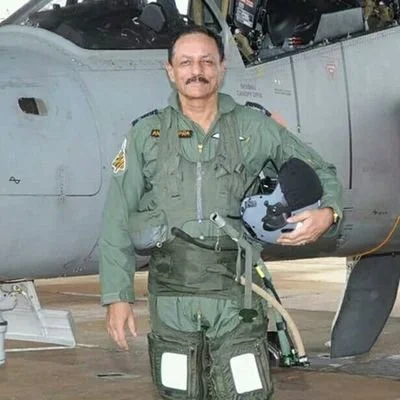
The Western avionics, including electronic warfare systems were more sophisticated. Russians used brute power there too. Russian aircraft required greater stick displacement for any aircraft response, it was much lesser in Western aircraft. This was as per their concept. This had its own dynamics when one changed fleet from Russian to Western aircraft or vice-versa. Pilots had to be cautioned for this. Russian cockpit switches were much larger and easy to operate in the cockpit, the Western were smaller and one had to get used to them while operating with gloves on. The Russian and Western artificial horizon instrument display was quite different. In Russian aircraft the artificial horizon bar turned with the aircraft, thus remained parallel to the aircraft and not to the actual horizon. The aircraft symbol/bar moved twice the degrees to indicate the bank. This worked well when one was head-down. Most pilots really liked this instrument (AGD). In the Head Up Displays of initial Russian aircraft they replicated the same display. This was most confusing because the displayed horizon was different than the real one. We discussed this with the Russian test pilots who had flown some Western aircraft. They also tended to agree with us on this. It took us a great effort and pressure to convince the Russian designers to redo the software to make the MiG-21Bison HUD similar to the Western symbols and logic. Russian designers were not very happy about this. Russian inner helmets were standardised between pilots, tank crew, and even ship or submarine crew. Russian radio navigation system (RSBN) was quite different to the Western TACAN. I found the Russian system very complex and many ways less accurate. The fighter aircraft Air Speed Indicator (ASI) started from 200 km/h, unlike the Western aircraft.
Soviets/Russians remained more than a match for the Western world. They often achieved results with simpler and cheaper means. After all, they were the first to put a man in space and even today are moving ahead with hypersonic weapons. They are being accused by Americans of a cyber-war, so they are still generally demonstrating asymmetrical innovation. There were many more peculiarities of aircraft of both philosophies. Since I have been out of fighter cockpits for some years, I may not remember everything off the top of my head.”
How effective an interceptor do you think it is? How good are the sensors and weapon systems?
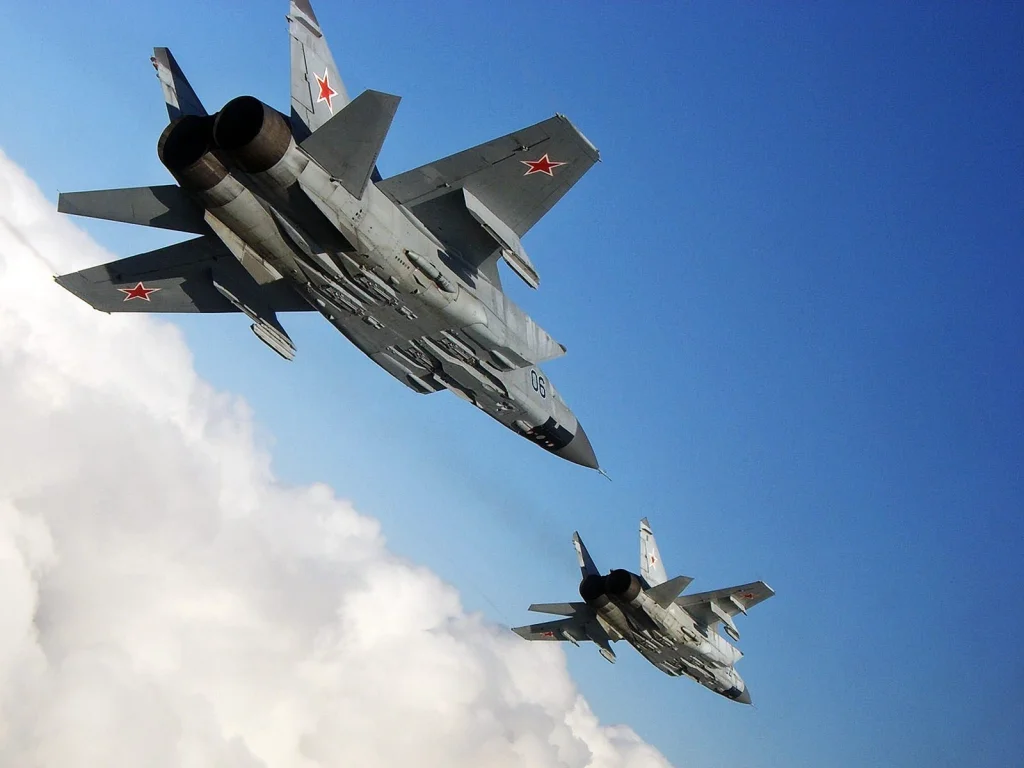
“For a successful interceptor, the key attributes are a good radar with long-range detection and tracking, good situational awareness with wider coverage, ability to handle multiple targets, and ECCM features. The MiG-31 radar was indeed powerful and had a good range. I was demonstrated a target at around 185 km range. Also I did see the look-down capability. Beyond that it was difficult for me to comment. In any case the radar and displays would have improved in manifold ways since then. Russian radar and missile combinations have generally done well in some wars including Vietnam and in the Iraq/Iran wars. Though there were other factors for success. Yes, the Americans were able to deceive or jam them with powerful electronic platforms, when they were introduced. Russians believed in brute power in the radar output. Undoubtedly Western avionics are generally better than the Russian ones. Russian missiles are indeed world-class.”

The Hush-Kit Book of Warplanes will feature the finest cuts from Hush-Kit along with exclusive new articles, explosive photography and gorgeous bespoke illustrations. Order The Hush-Kit Book of Warplanes here

Tell me something I don’t know about the MiG-31
“Well, Hush-Kit is an alternative aviation magazine of international repute. There is little that you all do not know and I would know. I am a “ageing foggy aviator”. If I was to summarise my flight, I felt I was sitting atop a missile-head in a high-speed interception. The aircraft looked good and was made of razor sharp nickel steel and other metal edges. I liked the white and blue colour scheme. As someone once wrote, I don’t recall who, that comparing the MiG-31 with Rafale is like comparing Bruce Lee with a Para Special Forces commando. Sure Bruce Lee was much faster with his arms & legs but he couldn’t operate 14 different kinds of guns, run 40 km with a 25 kg backpack, navigate through jungles, perform special recon behind enemy lines, kill anyone just with a kitchen knife & rescue hostages. The MiG-31’s cardinal flaw was lack of versatility, and it is too big and clumsy for use in dogfights. That is how the Sukhoi family of Su-27 variants over took from the Mikoyan designs. The MiG-31 is a formidable machine which had its time.”

Describe the aircraft in three words
“High speed brute.”
How many other Indians have flown the aircraft?
“I am not sure if anyone else has ever flown it. I was told that I was the first foreign pilot. As far as I know, no formal flight evaluation was ever done by IAF. Maybe some team went to have a look at the aircraft and had some formal discussions. But I may be wrong on this score. But India was never interested.”


Interesting article. The cockpit photos will probably be of interest to modelers; and even to those of us who used to do aircraft modeling.
Super Anil!!🙏
interesting article. I agree the MIG-31 is built for a very specific Russian need, i.e to defend its massive airspace with fewer platforms. I doubt any nation needs a M3 heavy interceptor. As a strike platform with Kinzhal, its potentially devestating. It will be interesting to see what they come up with for Mig -41